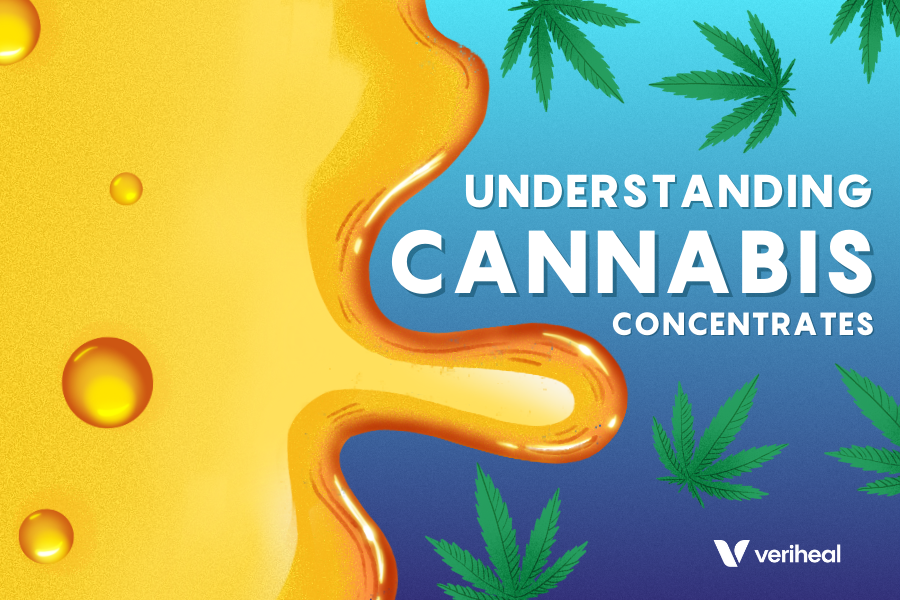Most cannabis users are familiar with good old natural flower, but cannabis concentrates are an entirely different category of their own. Products such as shatter, budder, and crumble might sound puzzling, but these are actually just different forms of concentrate, the final product of a process that extracts terpenes and cannabinoids (e.g., THC) from a cannabis plant.
In this ultimate guide, we’ll cover the basics of cannabis concentrates and compare them to flower before breaking down the most common concentrates (also sometimes called extracts) found at dispensaries. For an in-depth look at dabbing concentrates and other methods of consuming them, check out this article.
- Introduction to Cannabis Concentrates
- Concentrates vs Cannabis Flower
- Types of Cannabis Concentrates
- The History of Concentrates
Introduction to Cannabis Concentrates
It’s easy to get lost in the diverse variety of cannabis concentrates, but the simplest way to differentiate between them is by the method of extraction. Extractions done using chemicals such as ethanol, CO2, and butane are called solvent extracts—this includes wax, shatter, live resin, and more and makes up the majority of concentrates you’ll see on dispensary shelves.
Solventless concentrates, such as kief and bubble hash, are free of chemicals and made with the aid of ice, heat, and/or pressure. While solventless cannabis concentrates are more natural, solvent concentrates are currently considered just as safe to use. Despite the fact that solvent concentrates are made with the use of chemicals, proper chemical extraction leaves behind little to no harmful by-product.
Concentrates can be consumed in a number of ways, but the most common method is dabbing them using a dab rig or dab pen. Vape pens and cartridges also contain cannabis concentrate, often in the form of distillate. Most store-bought edibles are made using concentrate/extract as well, but edibles are generally considered to be a separate category of products. Finally, concentrates can be smoked (e.g., putting kief on a bowl of ground flower or wrapping a joint with wax).
Concentrates vs. Cannabis Flower
There are plenty of cannabis connoisseurs ready to vouch for both cannabis concentrate and flower as the best cannabis product, in addition to many who dabble in both. Both products have pros and cons depending on a user’s needs, so the decision is ultimately a personal one. Whichever you choose, it’s important to know some of the basic differences between them to make a more educated decision.
Cannabis concentrates, whether in the form of wax, oil, or tinctures, are essentially the same as cannabis flower—just, as the name suggests, in a high potency concentrated form free of plant material that can be efficiently vaporized. Dabbers can even find extracts with full cannabinoid and terpene profiles, meaning they have the multiple compounds thought to create the entourage effect that amplifies a user’s benefits from cannabis. No matter the consumption method, the effects of each are similar in type but quite different in strength.
Concentrates—particularly when dabbed—will get a user higher than flower due to the higher THC levels. To compare the difference in potency to alcohol, smoking flower is like drinking a beer, and dabbing concentrates is like taking a shot. Plant material tends to have around 15-30% THC content, whereas concentrates hit the 50-80% THC mark. But more THC is not always better for new cannabis users or users with low tolerances, as high amounts can cause anxiety. Keep in mind that high THC content will also increase tolerance, meaning you’ll need more and more THC to achieve the same effects.
Types of Cannabis Concentrates
Cannabis concentrates come in a variety of textures and potencies. A lot of these factors depend on the extraction method used to obtain the concentrate. Below, read about every different type of cannabis concentrate.
Solvent Cannabis Concentrates
Solvent-based extractions use chemical solvents such as ethanol, carbon dioxide, butane, or propane to strip cannabis flower of its resin. Because chemical solvents are highly flammable, extractors use what’s called a closed-loop system to ensure that there is no air exposure. This avoids risks of fire, over-pressurization, or explosion. Closed-loop systems also create a higher-quality extract with trace to no residues.
After a solvent has passed through the flower and collected the cannabinoids, the resulting product is referred to as “slurry.” Slurry is a cannabis extract mix of cannabinoids and residual solvent. The appearance can vary depending on what solvent is used. In order to process the slurry into the finished product, it needs to be purged.
In any solvent-based extraction, such as the production of butane hash oil (BHO) and other cannabis oil purging is required to rid the product of any leftover solvent. Purging can be done through a variety of methods, such as evaporation, vacuuming, or hand-whipping. Each method produces a different end product and signature consistency.
Wax, Budder, and Badder
Wax is the most well-known type of concentrate. It’s made by blasting plant material with a solvent using a closed-loop extraction system. The slurry is then heated at low temperatures and whipped to remove all residual solvent. Because the product is whipped by hand, it gains airy peaks (just like whipped cream).
Wax is generally dry and notably more crumbly than its counterpart budder. Budder is essentially wax with higher moisture content. The consistency of budder is oily and malleable, while wax concentrates are crumbly and solid. Colors will range from a variety of amber shades complete with a milder aroma and flavor profile.
Badder is a cannabis concentrate that has a whipped consistency similar to cake batter or thick frosting.
Live Resin
Live resin is made very similarly to wax; however, the starting product is frozen fresh plant matter. The finished product has robust terpene and cannabinoid profiles that resemble the qualities of the live plant. Because of this, it has strong aromas and flavors that are similar to the live plant. The appearance ranges in color from light amber to yellow-gold and is moist and shiny.
Diamond
Known for its distinct similarity to diamonds, THCA crystalline is a pure, refined product that is created by using solvent-based extraction methods. THCA crystalline looks like a fine powder, but when left to properly form, large crystals appear. Consuming pure THCA is a different high than most because it is incredibly potent and there is little to no terpene content. THCA diamonds are usually mixed with high-terpene concentrates to form “sauce.”
Shatter
Once the slurry is collected onto parchment paper, it’s placed in a vacuum oven for purging. The shatter starts to take shape and slowly spreads across the paper, taking anywhere from 45 minutes to a full day to achieve optimal consistency. Sometimes, if certain steps in the extraction process go wrong, shatter can have a “taffy” texture. Taffy is closer to budder in its consistency and stability. Shatter ranges in color from light to dark amber and is high in terpene content. High terpene profiles result in a strong aroma and flavor.
Distillate
Distillate is a newer development and uses high-tech equipment to vaporize THC and CBD within the flower. Then, it cools the vapor into collection beakers. This process is continuously repeated to create pure cannabinoids without any residual solvents or organic matter. The process of distillation leaves little terpene content. However, terpenes are often re-added to create specialized flavors.
Check out this article for more information on distillate: THC Distillate: What It Is and How to Use It
Honeycomb/Crumble
Much like shatter production, the slurry for honeycomb—also referred to as crumble or pie crust—is collected onto parchment paper and placed into a vacuum oven for purging. After, the concentrate patty is pressed. This turns it from a shiny shatter-looking substance to more of a cookie crumble/honeycomb look. It has an amber appearance with strong flavors and aromas.
Solventless Cannabis Concentrates
Non-solvent extraction processes typically use ice or ice water to freeze cannabis flowers to sub-zero temperatures and then agitate the resin glands to detach from the flower. Sometimes dry sift, heat, and pressure are used as an extraction method as well.
As mentioned earlier, non-solvent concentrates are considered a healthier form of concentrate due to the absence of solvents. However, all medical and legal solvent-based cannabis concentrates produced are purged and tested extensively to ensure residual levels are in accordance with local regulations (usually in PPM).
Solventless extraction processes result in products that have a higher potency than solvent-based extractions. These remain popular with consumers who care about what chemicals they’re ingesting. Because there are no chemicals introduced to the process, the organic profile of the plant remains unaltered, resulting in rich and complete terpene and cannabinoid profiles.
Kief
Kief is the simplest and most traditional type of concentrate available. The process used to extract it typically involves cannabis flower filtering screens or tumblers. By rubbing the flower against the screen, trichomes are agitated and isolated, effectively accumulating a collection of trichomes. Anyone can extract their own kief through a three-chamber grinder, which features a screen in the bottom level to help collect the trichomes.
Kief is very fine in texture and often takes on a light brown or tan coloring while mimicking the flavor of the flower it came from. It can be used on top of a bowl or consumed on its own. This form of cannabis is very potent because the majority of cannabinoids and terpenes are found in trichomes.
Check out this article for more information on kief: Discover Kief and the Many Things You Can Do With It
Live Kief
Live kief is made from fresh-frozen flower. The plant was cut at harvest and immediately frozen to preserve all of the cannabinoids and terpenes of the live plant. After a quick liquid nitrogen bath, live kief is extracted through agitation. Live kief is known for being potent, flavorful, and aromatic.
Bubble Hash
Bubble hash is a non-solvent product made using ice, water, and fine micron bags to isolate the trichomes and filter out plant material and other waste. Then, it is left to dry in the dark for about a week. Once dried and solidified, it’s ready for use. Producing bubble hash is debatably the safest extraction technique known to man.
Rosin
Producing rosin involves the use of high heat and high pressure on bubble hash to isolate the resin from trichome heads to create a solid form of resin. Rosin is probably the easiest and safest way to make concentrates. Rosin is one of the only types of concentrate that is a direct reflection of the starting material used. That means without exceptional starting material, it’s impossible to make high-quality rosin.
Live Rosin
The key difference with live rosin is that the starting plant material is not cured before the trichomes are harvested. Live, fresh-frozen plant material is used to make the bubble hash starting material. Then, heat and pressure are applied. Because there are more terpenes involved with fresh plant matter, it creates a final product that exudes flavor similar to the terpene profile of the live plant it was extracted from.
The History of Concentrates
Various forms of cannabis concentrate have been around for centuries, but the practice of consuming them only became widespread over the last decade or two. Let’s look at some of the biggest milestones in the history of cannabis concentrates.
10,000 B.C.: Hashish
The OG cannabis concentrate. Use dates back to 10,000 B.C. in China. Made by gathering a mound of kief or resin.
1943: U.S. Intelligence Usage
According to declassified documents, the Office of Strategic Services, or OSS (the precursor to the CIA), developed hash oil concentrate to aid interrogation of war criminals. The liquid concentrate was injected into tobacco cigarettes, as inhalation seemed to produce the most immediate results.
1950s: Hot-Knifing
The precursor to dabs, hot knifing involves placing a small bit of wax on a red-hot knife. The resulting vapors are subsequently inhaled.
1977: DIY Hash Oil
In 1977 Michael Starks wrote the book “Marijuana Chemistry: Genetics Processing and Potency,” providing clear, detailed instructions for at-home hash oil production using a variety of solvents to separate and extract THC.
2000-2009: Solvent Hash Oils
High-quality solvent-based hash oils became popular. By 2010, hash oil products made their debut at the High Times Cannabis Cup, and shortly thereafter, dispensaries were beginning to carry early versions of budders, saps, and waxes at a much more fervent rate.
2013: Rick Simpson Oil
Rick Simpson develops his own concoction of THC concentrates called Rick Simpson Oil (RSO) and applies it to the cancerous spots on his face and neck. According to Simpson, the spots healed within a few days. This has yet to be replicated clinically.
Mid-2010s: Vaporizing and Dabbing
As consumption gained popularity, the invention of delivery continued to improve. Dab rigs (essentially the bongs of the concentrate world of cannabis) were developed to efficiently consume concentrates. As the act of dabbing can be overly complicated, vaporizers and vape cartridges filled with cannabis oil became another viable, discreet option.
2019: Vape Crisis
Vape pens become the center of controversy due to a string of acute lung illnesses and deaths that occurred from vaping illicit-market, unregulated THC products. This health crisis was actually due to a high amount of a contaminant called vitamin E acetate, not because of cannabinoids or natural cannabis plant compounds.
Inhaling such a contaminant leads to an unsafe balance of lipids (fats) in the lungs, resulting in EVALI (e-cigarette or vaping-associated lung injury) presenting as ARDS (acute respiratory distress syndrome) and heart failure. However, this strongly demonstrates the need for safely produced and third-party tested products that can be obtained only through legal and well-regulated marketplaces.
This article was originally published in March 2022 and last updated September 2023.
Author, Share & Comments








